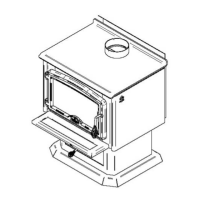Page 27
Installation and Operation Manual - 2000
ENGLISH
Peel off more of the backing and rotate the glass and press the next section onto the gasket. Do
not stretch the gasket as you place it. Continue until you get to the start and trim the gasket to
length. Now pinch the gasket to the glass in a U shape, all around the glass. Reinstall the glass,
being careful to centre the glass carefully in the door.
Do not over-tighten the screws. Note that the two main causes of broken door glass are uneven
placement in the door and over-tightening of retaining screws.
Do not abuse the glass door by striking or slamming shut. Do not use the stove if the
glass is broken.
To replace the glass (D), remove the eight
screws (A), the eight glass retainers (B), and
the metal frames (C). Remove the damaged
glass and install the new one in place. Make
sure you have a gasket around the replacement
glass (see procedure above). Put back the
metal frames and the glass retainers and
secure to the door frame (E) with the screws
removed earlier.
A
B
C
D
E
F
Figure 20: Replacing the glass
5.1.5 Cleaning and Painting the Stove
Do not attempt to clean or paint the stove when the unit is hot. Painted surfaces can be
wiped down with a damp cloth. Plated surfaces may be scratched by abrasive cleaners. To
maintain the finish at its original brilliance, use only a damp soft cloth to clean plated surfaces.
If the paint becomes scratched or damaged, you can give your wood stove a brand new look by
repainting it with heat-resistant paint. Before painting, roughen the surface with fine sand paper,
wipe it down to remove dust, and apply two thin coats of paint. For best results, use the same
paint that was originally used on the stove, which is available in spray cans. See your dealer for
details.
5.2 Chimney and Chimney Liner Maintenance
5.2.1 Why Chimney Cleaning Is Necessary
Wood smoke can condense inside the chimney liner and chimney, forming a combustible deposit
called creosote. If creosote is allowed to build up in the venting system it can ignite when a hot
fire is burned in the stove and a very hot fire can progress to the top of the chimney. Severe
chimney fires can damage even the best chimneys. Smouldering, smoky fires can quickly cause
a thick layer of creosote to form. When you avoid smouldering so the exhaust from the chimney
is mostly clear, creosote builds up more slowly. Your new stove has the right characteristics to
help you to burn clean fires with little or no smoke, resulting in less creosote in the chimney.

